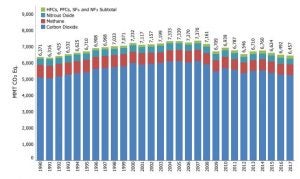The Environmental Protection Agency yesterday reported that that the US made essentially no progress on climate pollution — an insignificant drop of 0.5% — even as scientists warn that without major reductions in emissions, global temperatures are on a dangerous track to increase well above 2 degrees Celsius.
Other data indicates that since 2017, the last year covered by this report, emissions have actually begun to rise. The Energy Information Agency and Rhodium Group estimate that in 2018 climate pollution from energy combustion rose 2.8 and 3.4%, respectively.
As climate pollution remains stubbornly high, the Trump administration has worked to undermine limits on carbon pollution, roll back rules on highly potent methane emissions and ducked international obligations to deal with climate change. This new report is another sign that without bold action, climate pollution will cause worsening impacts on our economy, health and future.
The dismal national climate pollution numbers contrast with pollution reductions underway in many states that have put in place aggressive policies to limit emissions and move towards clean energy even while the federal government sits on the sidelines.
California is aggressively addressing climate pollution with multiple policies including a cap on climate pollution since 2013. From 2016 to 2017 California’s emissions decline was almost three times that of the U.S. as a whole. But even more importantly, California has seen emissions decline every year since the great recession whereas trends in the U.S. have vacillated between increases and decreases from year to year. The state has been able to achieve these reductions while both growing its economy and adding jobs faster than the national average.
Similarly, power sector emissions in the nine New England states participating in the Regional Greenhouse Gas Initiative (RGGI) have declined dramatically in the ten years of the program with a net economic benefit of $1.4 billion and 14,500 additional job-years in the last three years alone. Several other states are now seeking to link with RGGI and there are additional, significant carbon reductions planned in the region through 2030.
Many states are also pursuing opportunities for pollution reductions from transportation, with nine states and the District of Columbia announcing their participation in the Transportation & Climate Initiative process to establish a regional program that limits greenhouse gas pollution from the transportation sector.
The best science shows that in order to avoid the worst impacts of climate change, we must achieve net-zero climate pollution by 2050. Unfortunately, the latest data from EPA and elsewhere shows we’re not yet on the trajectory we need to be to get there. That’s why, for the sake of our children and future generations, we need our leaders at all levels of government to step up, take climate change seriously, and set clear limits on pollution.










